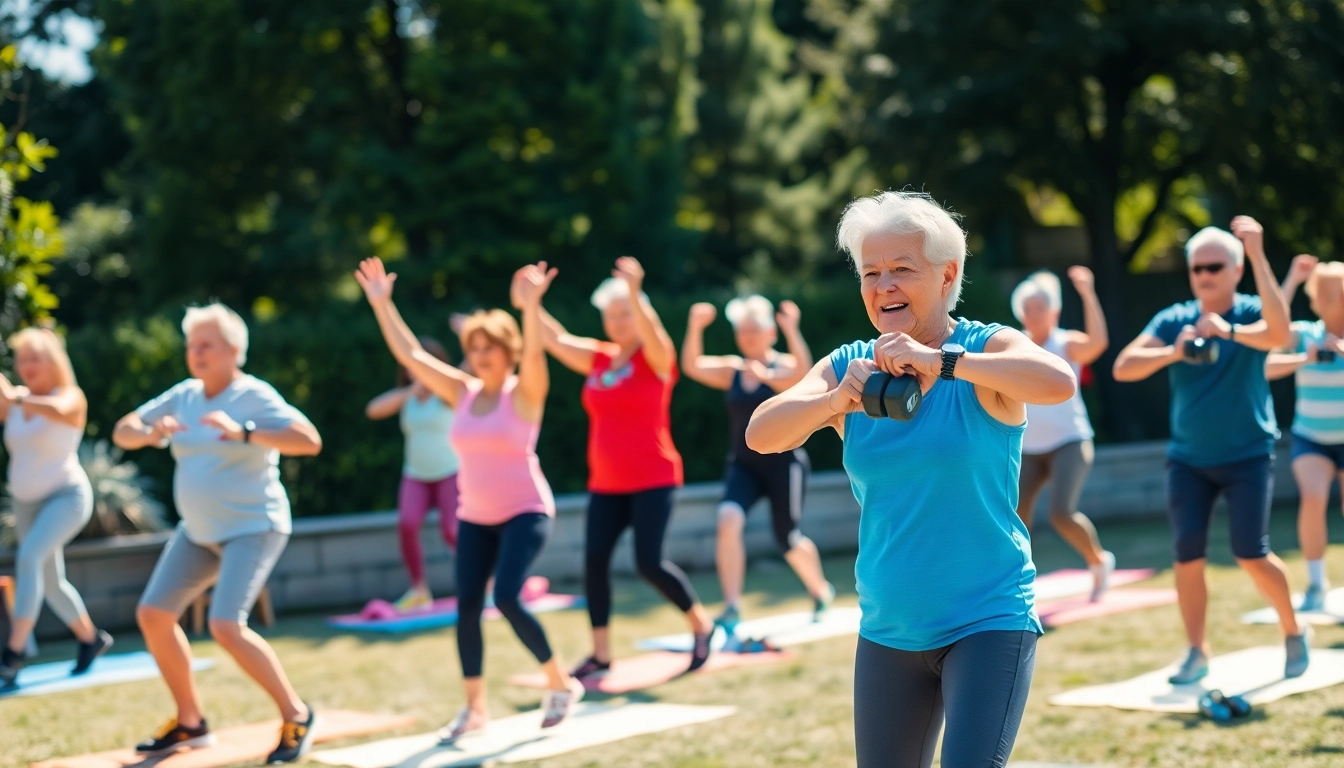Understanding the Importance of Senior Fitness Training
As we age, maintaining an active lifestyle becomes crucial for preserving health, mobility, and overall quality of life. Senior Fitness Training is not just about staying fit; it’s about fostering independence and enhancing mental well-being. This article delves deep into why fitness training is vital for seniors, exploring its physical and mental benefits, common barriers encountered, and how to overcome these hurdles.
Physical Benefits of Regular Exercise for Seniors
Regular exercise yields a host of physical benefits that are especially important for seniors. These benefits include:
- Improved Muscle Strength: Resistance training helps counteract muscle loss associated with aging, making daily tasks easier.
- Enhanced Flexibility: Stretching exercises increase flexibility, reducing stiffness and the risk of injury.
- Increased Bone Density: Weight-bearing exercises fortify bones, reducing fracture risks associated with osteoporosis.
- Better Cardiovascular Health: Aerobic activities enhance heart health, improve circulation, and reduce hypertension.
Incorporating regular exercise can lead to significant improvements in physical functioning, allowing seniors to maintain their independence and mobility. It is recommended that seniors engage in at least 150 minutes of moderate aerobic exercise weekly, coupled with strength training on two or more days a week.
Mental Health and Wellbeing Through Fitness
Physical activity does not merely contribute to physical health; it also plays a significant role in mental wellbeing. Some of the profound mental health benefits include:
- Reduced Symptoms of Depression and Anxiety: Exercise has been shown to alleviate feelings of sadness and anxiety, enhancing mood due to the release of endorphins.
- Improved Cognitive Function: Regular physical activity supports brain health and may reduce the risk of cognitive decline and dementia.
- Enhanced Social Interaction: Group exercise classes provide opportunities for social engagement, fostering a sense of community and support.
- Better Sleep Quality: Regular exercise helps regulate sleep patterns, which is often a significant issue among elderly populations.
The mental benefits of fitness training can be key in combating loneliness and isolation often felt by seniors, providing them not only with physical vitality but also emotional resilience.
Common Barriers to Senior Fitness and Overcoming Them
Despite the numerous benefits, many seniors face barriers when it comes to engaging in fitness programs. Some common obstacles include:
- Physical Limitations and Chronic Pain: Seniors may believe that certain physical conditions prevent them from safely participating in exercise.
- Lack of Motivation: A previously sedentary lifestyle can make it challenging to start a new fitness routine.
- Accessibility of Facilities: Limited access to fitness facilities and programs designed specifically for seniors can discourage participation.
Overcoming these barriers requires tailored solutions such as:
- Working with healthcare professionals to design personalized fitness plans that accommodate their physical conditions.
- Establishing small, attainable goals to build confidence and motivation.
- Utilizing home-based exercise programs and online resources to ensure accessibility.
By addressing these barriers directly, seniors can engage more fully in fitness training, reaping its many rewards.
Types of Effective Senior Fitness Training Programs
Multiple fitness programs cater to the varying needs and abilities of seniors. These programs often focus on different elements of fitness, including aerobic health, strength training, and balance. Here’s an overview of effective types of training programs for seniors.
Aerobic Exercises Suitable for Seniors
Aerobic exercises, also known as cardio, are activities that get the heart rate elevated. Ideal for seniors, these exercises can be adapted easily, allowing for varying fitness levels. Common types include:
- Walking: Simple yet effective, walking can be done at one’s own pace within various environments, indoors or outdoors.
- Swimming: An excellent low-impact workout that minimizes strain on joints while providing a full-body workout.
- Cycling: Whether on a stationary bike or on the road, cycling strengthens leg muscles and enhances cardiovascular health.
- Group Aerobics Classes: Many community centers offer classes designed for seniors, promoting sociability alongside fitness.
Encouraging regular aerobic activity can significantly boost cardiovascular health and promote overall fitness.
Strength Training: Building Muscle Safely
Strength training is essential for maintaining muscle mass and enhancing bone density. Seniors can effectively implement strength training with:
- Light Weights: Using light dumbbells or resistance bands can provide effective strength training without overexertion.
- Bodyweight Exercises: Exercises such as squats, lunges, and modified push-ups can help build strength without the need for equipment.
- Resistance Machines: Gyms often have machines designed for seniors, allowing safe and guided strength training.
Incorporating strength training into regular workouts not only aids in muscle maintenance but also supports overall metabolic health.
Flexibility and Balance: Preventing Falls
Flexibility and balance exercises are critical components of a senior’s fitness program; they help prevent falls—a major concern for this age group. Key practices include:
- Yoga and Tai Chi: These practices focus on gentle movements and balance, enhancing core strength and flexibility.
- Stretching Exercises: Daily stretching promotes flexibility and can help alleviate muscle tension.
- Balance Training: Simple activities like standing on one leg or using a stability ball can significantly enhance balance.
Regularly incorporating these exercises can drastically reduce the risk of falls, thereby promoting independence.
Creating a Personalized Senior Fitness Training Plan
Designing a tailored fitness plan is essential for seniors to maximize benefits while ensuring safety. A personalized approach acknowledges individual needs, preferences, and goals.
Assessing Individual Fitness Levels and Goals
Starting with a comprehensive assessment provides a baseline for designing an effective fitness plan. Elements to consider include:
- Current Fitness Level: Conduct simple tests to understand endurance, strength, and flexibility capabilities.
- Health Status: Consult with healthcare professionals to address any underlying health conditions affecting exercise capability.
- Personal Goals: Setting realistic short-term and long-term fitness goals keeps seniors motivated and engaged.
Such personalized assessments offer a roadmap that guides seniors towards achieving their health and fitness aspirations accordingly.
Incorporating Variety to Maintain Engagement
Variety is crucial in keeping seniors engaged and motivated to exercise consistently. A few strategies for introducing variety include:
- Mixing Exercise Types: Combining aerobic, strength, flexibility, and balance exercises keeps workouts fresh and stimulating.
- Changing Locations: Exercising in different environments—parks, community centers, or home—can inspire enthusiasm towards fitness.
- Joining Classes: Group activities or classes can introduce seniors to new forms of exercise while fostering social bonds.
Engagement is key to developing a long-term fitness habit that enriches their lives.
Scheduling Regular Assessments to Track Progress
Continuous monitoring of physical progress is vital to ensure the fitness program remains effective and relevant. Regular assessments should include:
- Fitness Gains: Track improvements in strength, endurance, flexibility, and balance through assessments every 4 to 6 weeks.
- Adjusting Goals: Revising fitness goals based on progress ensures that seniors remain motivated and challenged.
- Feedback Loop: Encourage seniors to report their feelings and experiences during workouts to identify areas needing adjustment.
Regular tracking fosters accountability and celebrates progress, encouraging ongoing commitment to fitness.
Choosing the Right Resources for Senior Fitness Training
Access to quality resources is essential for the effective implementation of a senior fitness program. Resources must be reliable, engaging, and tailored for the senior demographic.
Certified Trainers Specializing in Senior Fitness
Working with certified trainers who specialize in senior fitness can enhance a senior’s workout experience significantly. Benefits include:
- Expert Knowledge: Trainers understand the unique physical and medical considerations necessary when structuring exercises.
- Motivation and Accountability: Instructors provide continual motivation and support, fostering a consistent workout regime.
- Customized Plans: They tailor fitness programs precisely to individual needs, ensuring safety and effectiveness.
Such trainers play an invaluable role in guiding seniors through their fitness journeys.
Online Courses for Remote Learning Options
Many seniors find online platforms offering courses valuable for their fitness needs. Options to consider include:
- Structured Online Programs: Courses designed specifically for senior fitness provide guided directions on safely engaging in workouts.
- Community Forums: Interactive platforms allow seniors to connect with peers, sharing tips and encouragement.
- Flexibility: Online fitness courses provide the flexibility to exercise from home at their own pace and comfort level.
By leveraging online resources, seniors can stay engaged with fitness routines in a manner that is convenient and accessible.
Utilizing Mobile Apps for Senior Fitness Guidance
Mobile apps are emerging as excellent tools for promoting senior fitness. Key advantages of using fitness apps include:
- Exercise Tracking: Many apps allow users to log workouts and track progress, helping to maintain accountability.
- Guided Workouts: Video demonstrations and detailed instructions can guide effective and safe exercise execution.
- Goal Setting: Most apps enable users to set fitness goals, providing step-by-step recommendations toward achievement.
These digital tools can empower seniors by offering support and guidance at their fingertips.
Measuring Success in Senior Fitness Training
Measuring the success of a senior fitness program involves evaluating both physical and emotional aspects. Success indicators provide insights into the effectiveness of training interventions.
Setting Realistic Milestones and Goals
Establishing milestone goals fosters a sense of achievement and progression. Important considerations include:
- Short-Term Goals: Focus on specific, attainable objectives—such as walking for 10 minutes daily—providing immediate satisfaction.
- Long-Term Goals: Broader objectives, such as participating in a community fitness event, can keep motivation high.
- Celebrating Achievements: Recognizing when milestones are achieved encourages ongoing commitment and positive reinforcement.
The act of setting and achieving goals enhances motivation by demonstrating progress.
Feedback from Participants: Gathering Insights
Encouraging participant feedback on fitness programs can provide valuable insights for ongoing improvement. Strategies include:
- Surveys and Evaluations: Conduct periodic surveys on program satisfaction and areas requiring enhancement.
- Open Communication: Create an environment that welcomes feedback and suggestions, allowing seniors to voice their experiences.
- Focus Groups: Consider regular focus group discussions to capture more in-depth thoughts on the fitness program.
Feedback collection fosters a sense of ownership and provides data to refine program effectiveness.
Adjusting Programs Based on Results and Feedback
Continuous improvement is essential for maintaining program relevance and effectiveness. Steps to adjust programs include:
- Analytical Reviews: Regularly review data collected from progress assessments and participant feedback.
- Adaptive Changes: Be prepared to modify workout plans to better suit the evolving fitness levels and interests of seniors.
- Trial New Approaches: Introduce new classes or activities based on trending interests among participants to keep engagement high.
Adapting programs based on results ensures lasting success and participant satisfaction.



